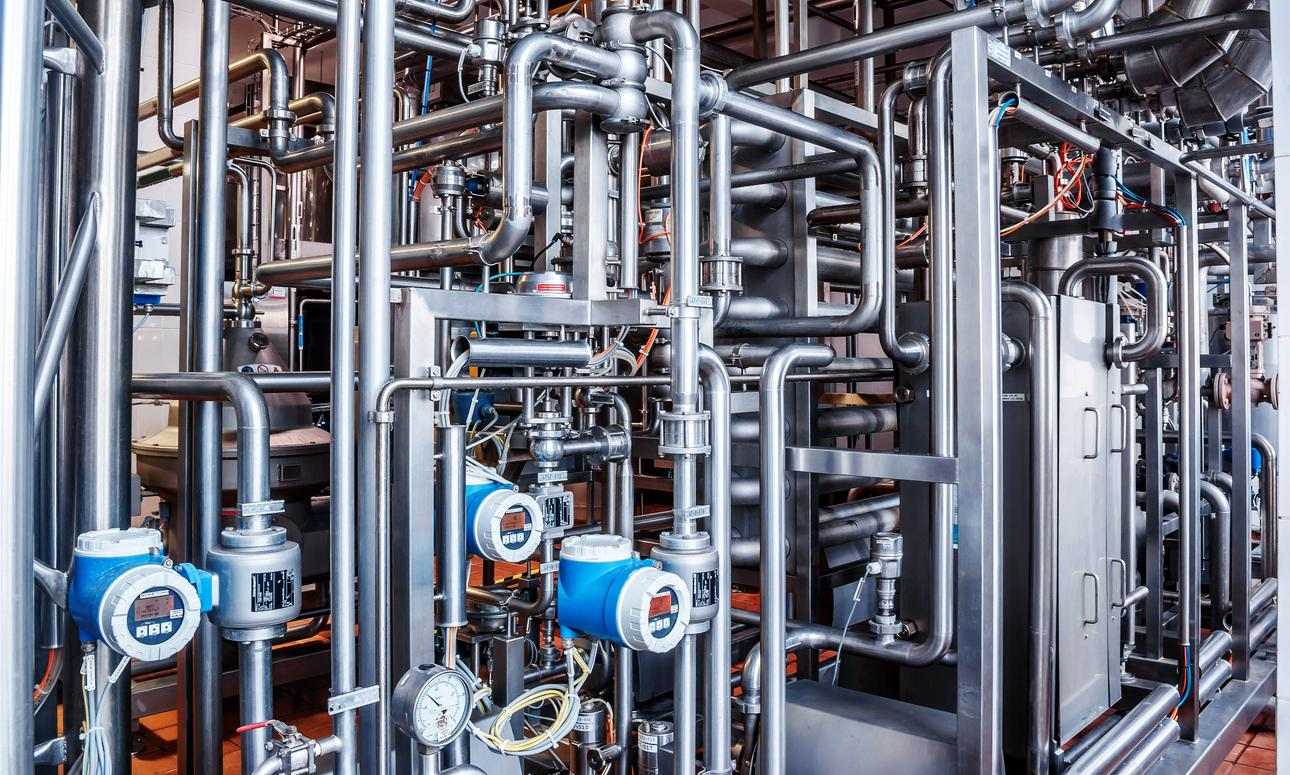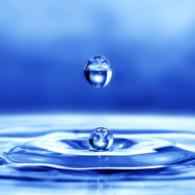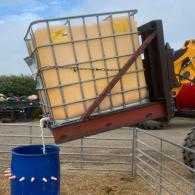A clean evaporator provides for consistent, efficient, economical and trouble-free operation. Clean heat exchange surfaces, tubes and plates mean lower heat energy is required which, in turn, will deliver a reduced operating cost. Clean evaporators can also enable longer product runs, fewer shut-downs per week, and improved product quality.
It is estimated that 1/16 of an inch of soil on the tube surface will cause approximately 12% loss of efficiency in the evaporation.
Falling film evaporators are most prevalent in the dairy industry due to their lower energy requirements and safer operation with heat-sensitive products. During production, it is important to ensure that the distribution plate is level, hydraulic conditions (flow-rate) are consistent, and that product is properly distributed above the tube nest, otherwise, the tubes near the bottom could run dry thus causing the product to burn and soil.
Increasing the solid content of the product by using ultrafiltration and/or reverse osmosis systems prior to entering the evaporator can change the operating parameters and impact the soiling properties. Additionally, any disturbance in flow increases the possibility of fouling in the tubes.
Falling film evaporators used with milk and whey products can be cleaned by single-stage cleaning:
- Add a cleaning agent to the pre-rinse
- for milk add 0,5% NaOH + =,1% Complex
- for whey add 1% Nitric acid
- Use 1% NaOH + 0.4% Complex in the alkaline cleaning step
- Add 0.2-0.5% Nitric acid in the final rinse
Additionally, the chemistry should go through the evaporator as a concentrated plug in both the pre-rinse and final rinse stages.
Evaporator Cleaning
Evaporator cleaning programs range from simple to complex depending upon the relationship between equipment, soil loads, hours of operation, time available for cleaning and the choice of detergents.
Areas such as vapor separators, vapor crossovers, and the underside of the tube plates, utilize spray balls which require high flow-rates relying on lower impingement efficiencies to achieve satisfactory cleaning. The scrubbing action in the calandrias is accomplished by a thin film moving at high velocities and turbulence through the tubes. As the solution moves through the calandrias it is increasing in concentration due to evaporation which will provide a stronger cleaning solution discharged from the last effect where fouling of the tubes is sometimes a problem.
The most difficult areas to clean in an evaporator are the tubes and the underside of the distributor plate in the calandria. The steps below describe cleaning in place (CIP) guidelines for evaporators being cleaned in vacuum mode.
Typical CIP Program for Milk Products
(Whole milk / skim milk / buttermilk)
- Adequately rinse with potable water to remove loose and soluble solids from the system. Do not over rinse as this may cause soil load to adhere more to the product contact surface.
- Pre-wash with condensate of whey (COW) water while adding reclaimed caustic from the previous primary caustic wash. Do not circulate the prewash to avoid re-depositing gross soils on the distribution plate and in the spray devices.
- Intermittently rinse with potable water or COW water. It is preferable to drain long enough for good phase separation.
- If not using COW water for the primary caustic wash, add the appropriate amount of chelating additive. Adjust the reclaimed caustic with additional fresh caustic to achieve a concentration of 2 - 3% active causticity for the first effect. It is recommended to add a defoaming wetting agent, such as TendecTM, to control the foam profile and improve the cleaning performance. The higher temperature (especially in the first effect) will provide for an increased flash of caustic vapors across the top of the tube plate, thereby cleaning the underside of the distributor plate. The time of the primary caustic wash cycle may vary depending on soil load and length of production run. Generally speaking, four to five passes (based on the time required to complete one pass through the evaporator) are adequate for best cleaning results. After the primary caustic wash, reclaim the used caustic for the next day’s use.
- Pre-rinse using potable water or COW water until the system is close to pH 8.
- Acid wash using approximately 1% v/v solution of a blended nitric/phosphoric acid (i.e. Super DilacTM). If inorganic soil is tenacious, then add a wetting agent (i.e. TendecTM) to the acid wash to improve the overall cleaning performance. The time of the acid wash will be approximately 2-3 passes depending on the condition of the system.
- Final rinse using potable water until a neutral pH is obtained. During the final rinse, add enough acid to produce a 3-4 pH during the final pass through the evaporator. This will eliminate any hard water films and shine the surfaces.
- Open and inspect the cleaning result.
Typical CIP Program for Whey Products
(Whey / whey protein concentrates permeate as whey products)
- Adequately rinse with potable water to remove loose and soluble solids from the system. Do not over rinse as this may cause soil load to adhere more to the product contact surface.
- Pre-wash once through the evaporator to the drain with condensate of whey (COW) water while slowly adding some reclaimed acid from the previous primary acid wash. Be sure to add the acid slowly to avoid removing the acid soluble too quickly and possibly plugging the evaporator. Do not circulate the pre-wash to avoid re-depositing gross soils on the distribution plate and in the spray devices.
- Intermittently rinse with potable water or COW water. Preferably to drain long enough for good phase separation.
- Caustic wash at 1% active causticity and circulate for 1-2 passes. The caustic wash may not always be needed and is dependent on the amount of caustic soluble soils present. This step can be very flexible based on cleaning results.
- Post-rinse using potable water or COW water until the system is close to pH 8.
- Acid wash using approximately 2% v/v solution of a blended nitric/phosphoric acid (i.e. Super DilacTM). Add a wetting agent (i.e. TendecTM) to the acid wash to improve the overall cleaning performance. Maintain the same wash temperature as during the caustic wash step. Circulate the acid solution for 3-4 passes, depending on the condition of the system.
- Final rinse using potable water until a neutral pH is obtained. During the final rinse, add enough acid to produce a 3-4 pH during the final pass through the evaporator. This will eliminate any hard water films and shine the surfaces.
- Open and inspect the cleaning result.
Is your evaporator CIP program effective?
There are a number of parameters to consider when establishing the optimal CIP program for your evaporator:
- Is the evaporator CIP’d atmospherically or under vacuum?
- What product(s) is/are being processed and what is the processing time?
- What are the process flow rates and CIP flow rates?
- What is CIP volume? What is the time to make one pass through the evaporator?
- What is the potable water quality, such as hardness, chloride, iron and silica content?
- Is condensed (COW) water available for CIP?
- Are the reclaim wash solution vessels available?
- Is the CIP program manually controlled or automated?
- Are there any design concerns, such as materials used for construction, gaskets, sensitive instruments, etc.?
- What are the most difficult areas to clean in the evaporator?
Diversey CIPCheck can help you discover if your evaporator CIP program(s) is under-performing. Our team will conduct a detailed probe into the system design, cleaning procedures, and water, energy, and chemical usage, to provide you with a complete performance analysis which is benchmarked against industry standards.









